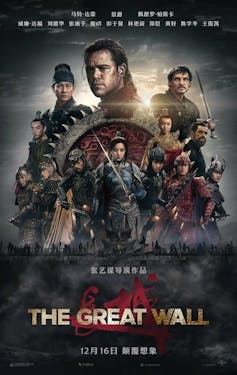Jurassic World: Fallen Kingdom, Hollywood’s most recent creature feature, has taken more than US $900m at the global box office in just a few weeks. August sees The Meg unleashed – based on Steve Alten’s novel, it’s a big-budget mega-Jaws featuring Jason Statham battling a 75ft megalodon. And from Pacific Rim (2013) to Godzilla (2014) and Rampage (2018), these monster blockbusters can tell us a story about how Hollywood sits in global cinema, especially its power relationships with Asia.
It is widely believed that the giant monster movie is an import from Japan – often referred to by its Japanese name, kaiju eiga (literally, strange beast films). In 1954, Gojira (Godzilla in English), in which a huge mutant dinosaur, awoken by nuclear tests, devastates Tokyo, set the template for films that manifest the devastating effects of humanity’s destructive excesses in the form of giant city-smashing monsters.This sci-fi sub-genre emerged from processes of cultural exchange, which helps us to see how one culture borrows or recycles material from another. Gojira borrowed aspects from two key American films: King Kong (1933) and The Beast from 20,000 Fathoms (1953), both released in Japan not long before Gojira’s conception. Gojira’s name is a combination of the transliteration of gorilla, and the Japanese word for whale, kujira. The producer’s working title was even The Giant Monster from 20,000 Leagues under the Sea.
Cultural exchanges have continued for a long time in this genre. American companies worked with Japanese studios to produce new versions of Godzilla and other kaiju movies. Collaboration with Japanese producers helped guarantee a steady supply of content for exploitation cinemas, drive-ins and later television, including Frankenstein Conquers the World (1965), King Kong Escapes (1967) and Yog: Monster from Space (1970).
Kaiju eiga were also produced across Asia, including Hong Kong, and South Korea. The most notorious example is North Korea’s Pulgasari (1985), produced by Kim Jong-il and directed by Shin Sang-ok, once South Korea’s most successful film producer, who was kidnapped by the regime and forced to improve their cinema.
Hollywood’s recycling habit
In Hollywood, global tropes are adopted and reworked – and their nostalgic (sometimes fetishised) referencing is rife at the moment. Pacific Rim called its monsters kaiju in homage to the genre’s Japanese roots – and its sequel’s climactic showdown occurs in Tokyo. Steven Spielberg’s Ready Player One (2018) depicts a future dystopia where the populace has retreated into a pop culture saturated VR game. When one of its protagonists fights the evil corporate executive trying to take over the game, they take the forms, respectively, of anime robot Gundam and 1970s Godzilla enemy, MechaGodzilla, both icons of Japanese popular culture.
Rampage is an adaptation of a 1980s video game in which giant monsters smash up cities. The largely plotless game spawned a film that critiques the dangers of genetic experimentation. Godzilla (2014) and Kong: Skull Island (2017) initiated a Marvel-style shared MonsterVerse. Godzilla: King of the Monsters was teased in the end credits of Kong, and the two kaiju will face off in 2019.
Eastern appeal
The Jurassic World films challenge similar cultural and political ideas. As cinema becomes more transnational, cultural exchange and a changing global marketplace challenge our understanding of traditional power relationships. Hence, there is a different reason why we should consider Jurassic World a kaiju movie: the ownership of its producers.
If you’ve been watching the World Cup, you’ll have seen hoardings advertising the Chinese company Dalian Wanda, one of China’s biggest conglomerates, who operate the world’s largest cinema holdings. In 2016, it paid US$3.5 billion for Legendary Entertainment, the production company behind the Jurassic World, Pacific Rim and Godzilla series.
An earlier deal with state-run China Film Group had granted Legendary Entertainment unparalleled access to the Chinese market through co-production deals. The Meg is also a Chinese co-production.
Localised strategies have also appealed to Chinese audiences. Chinese star Jing Tian has appeared in several Legendary monster films – as a military leader in kaiju martial arts spectacular The Great Wall (2016), a biologist in Kong: Skull Island and a famous scientist in Pacific Rim: Uprising. Star casting has long been one of the key techniques used by Hollywood to appeal to local markets. Locations are also important – the action in The Meg has been relocated from Maui in the novel, to China. Its cast also includes Li Bingbing, a Chinese star who also appeared in the most recent Transformers movie.
Legendary’s films demonstrate the mixture of local and global features at work. Legendary East and China Film Group
Several monster movies have recently grossed more in China than
 domestically in the US. Pacific Rim: Uprising grossed almost twice as much, and Rampage over 50% more. By contrast, Star Wars films make negligible impact at the Chinese box office – clearly monster content is more appealing to Chinese audiences.
domestically in the US. Pacific Rim: Uprising grossed almost twice as much, and Rampage over 50% more. By contrast, Star Wars films make negligible impact at the Chinese box office – clearly monster content is more appealing to Chinese audiences.This cycle of giant monster movies is currently the most prominent example of Hollywood’s globalised business. Its embrace of international material, familiar recycling and relationships with Asia are most strongly evidenced in these films. That’s not to say that all of this is new or one-way traffic: Legendary’s success with Godzilla inspired Toho studios to develop not one but two new series with the beloved national icon.
Read more


No comments:
Post a Comment